The market value of global brand giants tells an impressive story. Apple ($322,999 million), Amazon ($200,667 million), and Microsoft ($166,001 million) show how brand management creates astronomical value. These numbers highlight the impact of strategic brand-building, revealing the secrets of effective brand management in today’s competitive marketplace.
Brand management delivers more value than just a recognizable logo or catchy slogan. Companies can charge premium prices and build customer loyalty that influences buying decisions. Industry leaders like Coca-Cola, McDonald’s, and Nike have become skilled at these Brand management secrets.
This article reveals brand management secrets that top companies use to stay dominant. You’ll discover the psychological triggers, internal processes, and advanced tools that shape successful brand management in today’s ever-changing business environment.
The Hidden Psychology of Successful Brand Management
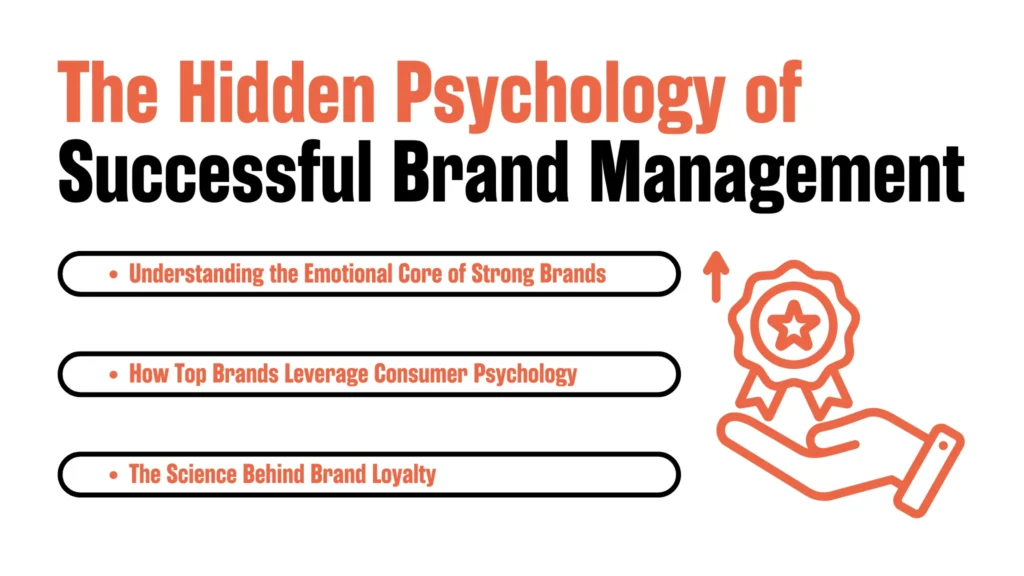
The success of brand management depends on how well we understand human psychology. Research shows that emotions guide 95% of purchasing decisions. Emotionally connected customers demonstrate 306% higher lifetime value than those who are just satisfied.
Understanding the Emotional Core of Strong Brands
Brands that leave a lasting mark go beyond simple utility. They connect with deeper emotional motivations. To name just one example, Airbnb built its brand around our need to belong. Their “Belong Anywhere” campaign recognized that people want more than a place to stay – they seek genuine connections. This emotional strategy contributed to their USD 47 billion IPO valuation.
How Top Brands Leverage Consumer Psychology
Modern brands use psychological triggers in many ways. Studies reveal that emotional advertisements work twice as well as rational ones, with success rates of 31% versus 16%. Brain research shows that consumers judge brands through emotional responses rather than facts.
Top companies achieve this through:
- Creating identity-based connections where consumers see the brand as part of themselves
- Building community-driven experiences that encourage belonging
- Developing consistent emotional associations across all touchpoints
The Science Behind Brand Loyalty
The neurological basis of brand loyalty reveals fascinating patterns. Research from the Wharton Neuroscience Initiative showed how brands create different levels of emotional-social connections in the brain. Apple customers’ brain activity matched patterns seen when viewing a loved one, showing their deep emotional bond with the brand.
Brand loyalty works on multiple levels. A newer study shows that 87% of repeat customers say their preferred brand makes them feel good. This ranks as the second most vital driver of loyalty after consistency. About 70% of consumers stress buying from the “right brand,” which reflects more conscious decision-making.
This analytical approach to brand loyalty reveals remarkable insights. Brain mapping studies demonstrate that customers with strong brand relationships show activity in brain regions linked to personal relationships and empathy. Brands that tap into these psychological mechanisms create what experts call “unconscious branding.” Consumers form subconscious brand associations even after they forget specific advertisements.
Internal Brand Management Secrets
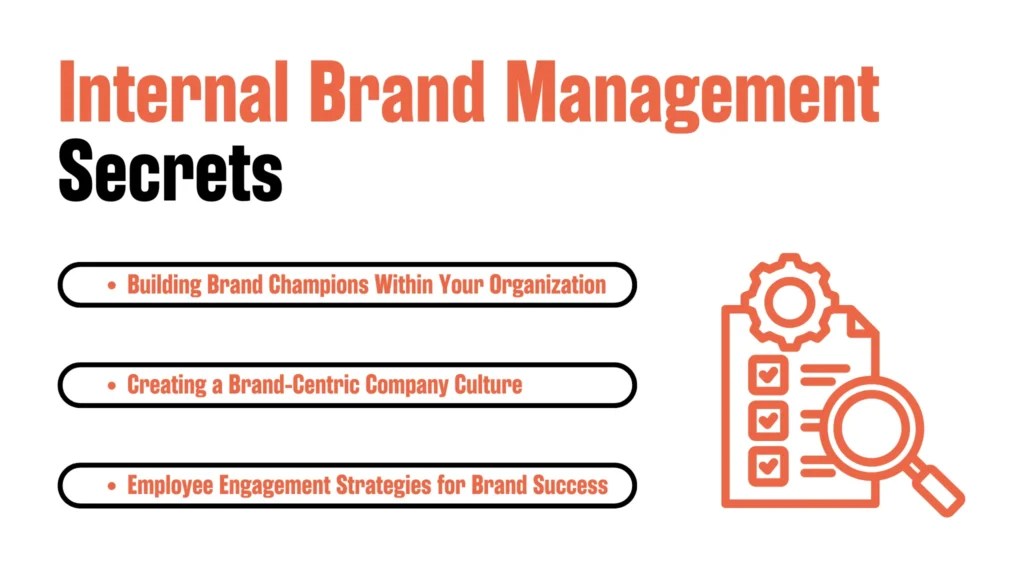
Strong brands start with engaged employees. Research shows that companies with highly engaged employees improve their operating income by 19.2% over a 12-month period. Loyal employees become powerful brand promoters, which directly leads to external success.
Building Brand Champions Within Your Organization
Brand champions emerge when employees truly believe in their company’s mission. Studies show that 79% of employees leave organizations because they don’t feel appreciated. Successful companies make employee recognition and meaningful involvement their top priorities. The numbers speak for themselves – 94% of employees stay with companies that invest in their professional growth.
Creating a Brand-Centric Company Culture
A company needs more than surface-level initiatives to build its internal brand. Organizations must develop a culture that lines up with their external brand promise. Companies with strong internal brands cut their hiring costs by half and reduce turnover rates by one-third.
Successful organizations build a brand-centric culture by focusing on:
- Clear communication of brand values and mission
- Regular brand education and training programs
- Consistent internal messaging across all channels
- Active employee participation in brand development
- Recognition programs that reinforce brand values
Employee Engagement Strategies for Brand Success
Employee engagement works both ways. Research shows that engaged employees are three times more trusted than CEOs in the marketplace when making purchasing or hiring decisions. U.S. businesses lose one trillion dollars each year due to disengaged employees.
Smart companies use proven approaches to boost engagement. A midsize company with 1,000 employees loses about $7.50 million yearly through attrition, including hiring and replacement costs. All the same, companies that value work-life balance and flexible arrangements see better retention rates.
Engaged employees affect more than internal metrics. Without a doubt, employees who feel valued and connected to the brand naturally become brand ambassadors. This connection shows up through increased efficiency, better customer service, and stronger brand representation in the marketplace. Companies that understand the link between employee satisfaction and brand success invest in detailed development programs to keep their workforce skilled and loyal.
Unconventional Brand Development Strategies
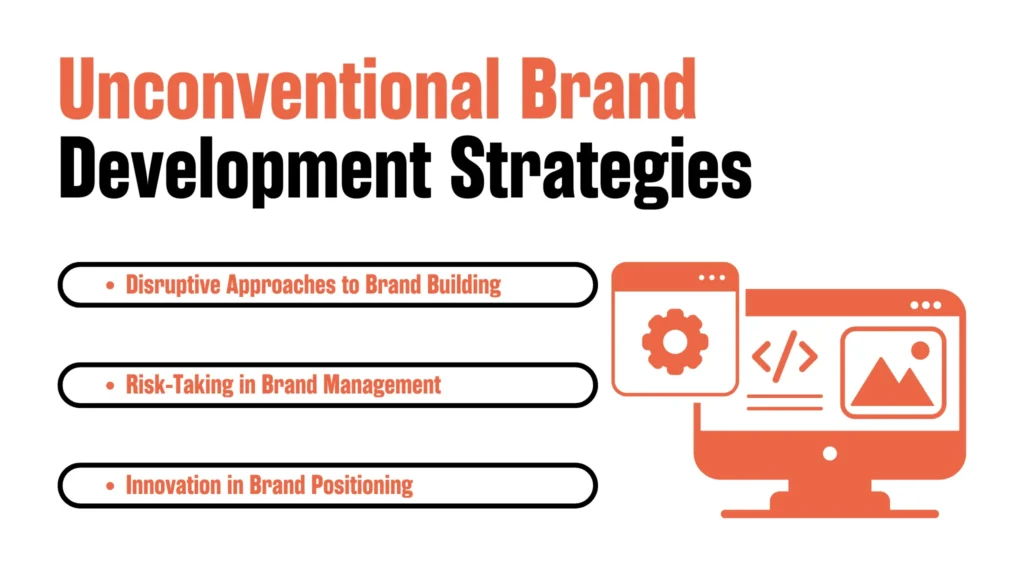
Brand development works best when you move away from the usual ways of doing things. Data shows that 66% of global consumers will pay more for brands that show fresh approaches. This proves why thinking differently matters so much in today’s brand management.
Disruptive Approaches to Brand Building
The best brands break away from old marketing methods and use creative disruption to grab market attention. Companies that tell real stories and build genuine connections see a 30% increase in sales. Dollar Shave Club showed how powerful viral content can be. Their different approach to entering the market got them 26 million views.
Risk-Taking in Brand Management
Smart risk-taking builds the foundation of fresh brand management. Studies show companies that set aside money to try new things reach more customers. Taking risks might seem scary, but companies with a “learn fast” mindset do better than those playing it safe.
These elements make risk management work in branding:
- Set testing rules beforehand to keep experiments in check
- Keep innovation budgets safe for new projects
- Check how the market responds often
- Change strategies based on what works
Innovation in Brand Positioning
You need deep market knowledge to position your brand in new ways. Companies that try creative positioning strategies see their brand awareness soar. The most successful brands look for unique features that make them stand out from competitors.
The best positioning strategies come from knowing how consumers think. Past studies show brands that focus on quality must know their target market’s buying habits and income levels. Brands that compete on price need to watch out for risks, like people thinking their products are cheaply made.
Unusual brand development works when you stay real while expanding boundaries. Numbers show that 55% of consumers buy more from brands that connect with them through creative storytelling. Brands that shake things up while staying true to their values grow steadily and win more market share.
Behind-the-Scenes Brand Management Challenges

Your brand’s reputation needs constant watchfulness in today’s complex business world. Companies that practice radical transparency see a 15% increase in customer retention rates during crises.
Common Pitfalls and How to Avoid Them
Brand management faces several challenges that can affect success. Inconsistent messaging causes a major drop in brand value and affects customer trust and market positioning. One of the most common pitfalls happens when organizations use stock images and phrases without thinking over their specific brand philosophy.
Key brand management mistakes you need to address:
- Value propositions that don’t connect with the target audience
- Brand messages that differ across channels
- Poor strategic decisions from weak market research
- Limited use of analytics in decisions
- Poor online presence management
Crisis Brand Management Secrets
Quick action and strategic planning make crisis management successful. Brands build stronger relationships when they respond to customer feedback, reviews, and complaints. Companies that use social listening tools to detect crises early maintain better brand resilience.
Crisis management works best with three steps: prevention, containment, and resolution. Brands that respond within the first hour of a crisis keep 33% higher customer trust levels. Open communication during tough times helps companies see better customer retention.
Adapting to Market Changes
Brands need continuous development to stay resilient in changing markets. Research shows that old brands can’t take the time they used to for brand-building. Successful adaptation needs a balance between consistency and innovation.
Brands must adopt change while keeping their core values intact. Organizations that set specific budgets for market adaptation strategies achieve 25% higher customer retention during economic downturns. Companies show stronger long-term performance when they review and adjust their brand strategies based on market changes.
Adaptation goes deeper than surface changes. Brands keep a healthy consumer base even during market changes when they focus on great customer service and reliable products. This flexibility, combined with strong crisis management plans, creates a resilient brand that withstands market pressures and maintains customer loyalty.
Hidden Tools of Brand Marketing Management
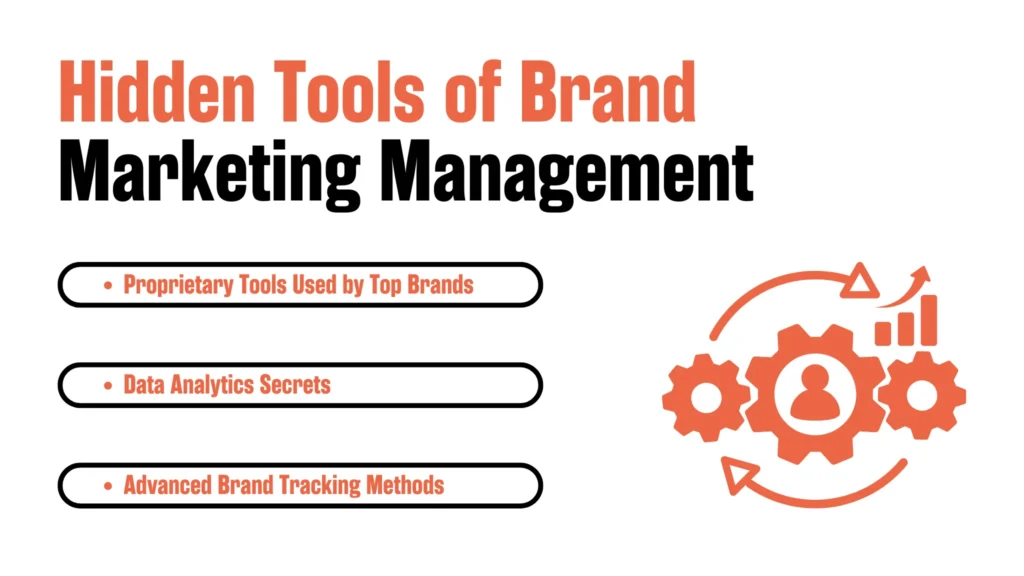
Modern brands rely on sophisticated tools and technologies to shape their market success. Companies that implement advanced analytics see a boost in their decision-making capabilities.
Proprietary Tools Used by Top Brands
Top brands employ specialized software platforms to manage their brands effectively. Bynder, a leading brand asset management system, lets teams create, access, and monitor branded digital assets from one central location. Meltwater’s suite offers media intelligence tools that show brand performance through media monitoring and public relations.
Brand management platforms focus on these core areas:
- Asset management and distribution
- Workflow and approval processes
- Version control systems
- Template creation tools
- Data analytics capabilities
Data Analytics Brand Management Secrets
Advanced analytics approaches come in three distinct categories: descriptive, predictive, and prescriptive. Humans excel at decisions that need intuition, while machines perform better at deductive reasoning and scalability.
Beyond simple metrics, leading brands use data analytics to:
- Analyze demographic patterns and behavior
- Create detailed customer personas
- Track user interactions across touchpoints
- Monitor key performance indicators
- Implement A/B testing strategies
Predictive analytics takes this further by forecasting future trends and behaviors. Machine learning algorithms analyze historical data to anticipate market trends, customer needs, and potential challenges.
Advanced Brand Tracking Methods
Brand tracking has evolved alongside technology. Measurement techniques like Media Mix Modeling (MMM) and Synthetic Holdout Groups give deeper insights into campaign performance. C-level leaders who prioritize marketing mix modeling are 2X more likely to exceed revenue goals by 10%.
Modern brand tracking works across multiple dimensions:
- Live, ad-based sampling for precise audience measurement
- Smart question attribution for niche audience insights
- Global reach accessing over 50 billion ad impressions daily
- Continuous data collection yielding up to 100,000 interviews annually per brand
Brand tracking tools now enable social media monitoring, giving instant access to brand conversations on platforms of all types. These tools analyze sentiment, gather feedback, and collect engagement metrics across channels.
Social functionality in proprietary tools marks another big advancement. Tools now include features like star ratings, reviews, and tagging capabilities that mirror successful online retail experiences. Organizations can better understand and respond to customer priorities while keeping their brand consistent across all touchpoints.
The Future of Brand Management
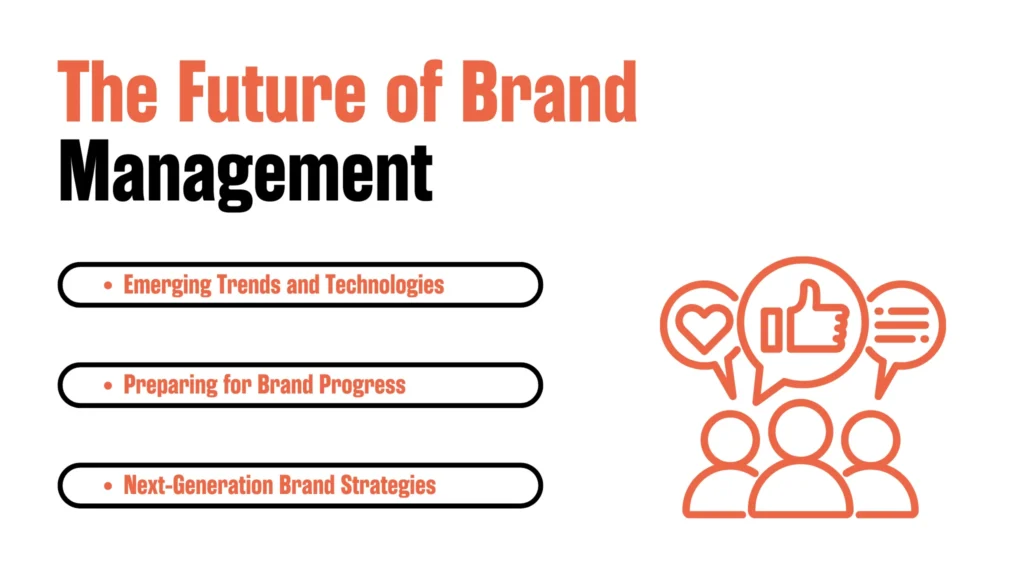
Brand progress plays a significant role in keeping market relevance and competitive advantage. Brands that guide customers during rapid changes build stronger trust and support.
Emerging Trends and Technologies
The brand management digital world is changing rapidly through technological advances. Studies show that 22% of customers leave frustrating experiences within one minute. These high customer expectations push state-of-the-art brand interactions forward.
Technology trends reshaping brand management include:
- Augmented Reality (AR) and Virtual Reality (VR) for immersive brand experiences
- Internet of Things (IoT) to improve customer connectivity
- Advanced data analytics for personalized interactions
- Voice-enabled brand interactions
- AI-powered customer service solutions
Research shows that 51% of customers welcome AI-boosted brand experiences, while 43% remain cautious about AI-driven interactions. This split highlights why brands must implement technology transparently in their strategies.
Preparing for Brand Progress
Successful brand progress needs a well-laid-out approach. Brands that keep consistent messages and respond quickly to customer concerns manage their reputation better. Organizations should develop detailed progress strategies accordingly.
Brand progress preparation focuses on:
- Creating appropriate brand foundations
- Establishing tools to evaluate brand relevance
- Developing processes to respond to market dynamics
- Building internal progress culture
- Documenting strategic processes
The difference between revolutionary change and gradual adaptation becomes significant over time. Studies show that smaller, continuous changes often bring better results than dramatic overhauls.
Next-Generation Brand Strategies
Future-proofing brands need forward thinking. Companies that blend eco-friendly and ethical principles into their operations see improved brand reputations. Successful brands watch technology trends, consumer behavior, and competitive landscapes actively to spot opportunities and threats.
Brand success depends increasingly on:
Informed Decision Making: Companies using advanced analytics and AI tools adapt better to markets.
Consumer-Centric Approaches: Brands focusing on authentic connections and transparency build stronger customer relationships.
Eco-friendly Practices: Companies that make environmental consciousness part of their brand strategy earn better customer loyalty.
Cultural Progress: Successful brands foster a culture of continuous adaptation within their organizations.
Tomorrow’s brand management must balance preservation with innovation. Brands that stay authentic while adopting technological advances create deeper emotional connections with consumers. Companies taking gradual approaches to brand development alleviate risks better than those making revolutionary changes.
Conclusion
Psychology, internal culture, and strategic breakthroughs shape modern brand management. Successful brands create deep emotional bonds and build strong internal foundations. Companies that excel at brand management strike the right balance between consistency and development.
Brands achieve remarkable results when they focus on emotional connections, involve employees, and advance technologically. Brand success goes beyond logos and slogans. It takes an all-encompassing approach that covers internal culture, crisis preparedness, and analytical insights.
Future brand management will need more adaptability and tech integration. Smart companies already use advanced analytics, make employee involvement a priority, and create crisis management protocols. The brand building comes with major challenges. Organizations that blend these elements while staying authentic to their values set themselves up for lasting success.
Brand management works best with constant attention and fine-tuning. Your journey can start with small, measurable changes based on these brand management secrets. Careful planning and consistent execution will help your brand develop the strength and resilience needed to lead the market.



